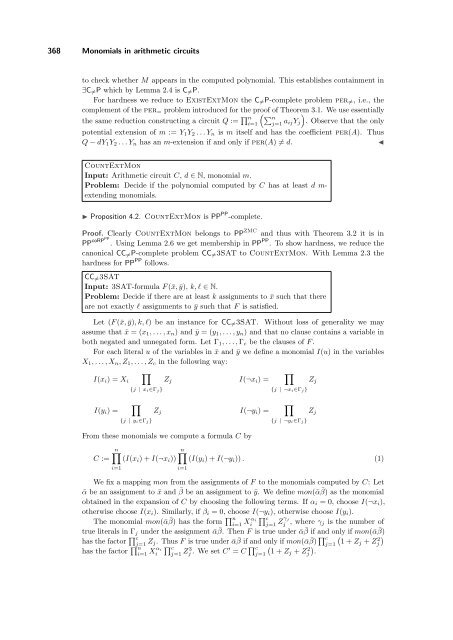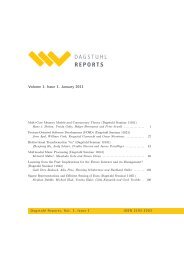Complete problems in the counting hierarchy - DROPS - Schloss ...
Complete problems in the counting hierarchy - DROPS - Schloss ...
Complete problems in the counting hierarchy - DROPS - Schloss ...
Create successful ePaper yourself
Turn your PDF publications into a flip-book with our unique Google optimized e-Paper software.
368 Monomials <strong>in</strong> arithmetic circuits<br />
to check whe<strong>the</strong>r M appears <strong>in</strong> <strong>the</strong> computed polynomial. This establishes conta<strong>in</strong>ment <strong>in</strong><br />
∃C�=P which by Lemma 2.4 is C�=P.<br />
For hardness we reduce to ExistExtMon <strong>the</strong> C�=P-complete problem per�=, i.e., <strong>the</strong><br />
complement of <strong>the</strong> per= problem <strong>in</strong>troduced for <strong>the</strong> proof of Theorem 3.1. We use essentially<br />
<strong>the</strong> same reduction construct<strong>in</strong>g a circuit Q := � n<br />
i=1<br />
� �n<br />
j=1 aijYj<br />
�<br />
. Observe that <strong>the</strong> only<br />
potential extension of m := Y1Y2 . . . Yn is m itself and has <strong>the</strong> coefficient per(A). Thus<br />
Q − dY1Y2 . . . Yn has an m-extension if and only if per(A) �= d. ◭<br />
CountExtMon<br />
Input: Arithmetic circuit C, d ∈ N, monomial m.<br />
Problem: Decide if <strong>the</strong> polynomial computed by C has at least d mextend<strong>in</strong>g<br />
monomials.<br />
◮ Proposition 4.2. CountExtMon is PP PP -complete.<br />
Proof. Clearly CountExtMon belongs to PP ZMC and thus with Theorem 3.2 it is <strong>in</strong><br />
PP coRPPP<br />
. Us<strong>in</strong>g Lemma 2.6 we get membership <strong>in</strong> PP PP . To show hardness, we reduce <strong>the</strong><br />
canonical CC�=P-complete problem CC�=3SAT to CountExtMon. With Lemma 2.3 <strong>the</strong><br />
hardness for PP PP follows.<br />
CC�=3SAT<br />
Input: 3SAT-formula F (¯x, ¯y), k, ℓ ∈ N.<br />
Problem: Decide if <strong>the</strong>re are at least k assignments to ¯x such that <strong>the</strong>re<br />
are not exactly ℓ assignments to ¯y such that F is satisfied.<br />
Let (F (¯x, ¯y), k, ℓ) be an <strong>in</strong>stance for CC�=3SAT. Without loss of generality we may<br />
assume that ¯x = (x1, . . . , xn) and ¯y = (y1, . . . , yn) and that no clause conta<strong>in</strong>s a variable <strong>in</strong><br />
both negated and unnegated form. Let Γ1, . . . , Γc be <strong>the</strong> clauses of F .<br />
For each literal u of <strong>the</strong> variables <strong>in</strong> ¯x and ¯y we def<strong>in</strong>e a monomial I(u) <strong>in</strong> <strong>the</strong> variables<br />
X1, . . . , Xn, Z1, . . . , Zc <strong>in</strong> <strong>the</strong> follow<strong>in</strong>g way:<br />
�<br />
I(xi) = Xi Zj I(¬xi) = �<br />
Zj<br />
I(yi) =<br />
{j | xi∈Γj}<br />
�<br />
{j | yi∈Γj}<br />
{j | ¬xi∈Γj}<br />
Zj I(¬yi) = �<br />
From <strong>the</strong>se monomials we compute a formula C by<br />
C :=<br />
i=1<br />
{j | ¬yi∈Γj}<br />
n�<br />
n�<br />
(I(xi) + I(¬xi)) (I(yi) + I(¬yi)) . (1)<br />
i=1<br />
We fix a mapp<strong>in</strong>g mon from <strong>the</strong> assignments of F to <strong>the</strong> monomials computed by C: Let<br />
¯α be an assignment to ¯x and ¯ β be an assignment to ¯y. We def<strong>in</strong>e mon(¯α ¯ β) as <strong>the</strong> monomial<br />
obta<strong>in</strong>ed <strong>in</strong> <strong>the</strong> expansion of C by choos<strong>in</strong>g <strong>the</strong> follow<strong>in</strong>g terms. If αi = 0, choose I(¬xi),<br />
o<strong>the</strong>rwise choose I(xi). Similarly, if βi = 0, choose I(¬yi), o<strong>the</strong>rwise choose I(yi).<br />
The monomial mon(¯α ¯ β) has <strong>the</strong> form �n i=1 Xαi i<br />
Zj<br />
� c<br />
j=1 Zγj<br />
j , where γj is <strong>the</strong> number of<br />
true literals <strong>in</strong> Γj under <strong>the</strong> assignment ¯α ¯ β. Then F is true under ¯α ¯ β if and only if mon(¯α ¯ β)<br />
has <strong>the</strong> factor �c j=1 Zj. Thus F is true under ¯α ¯ β if and only if mon(¯α ¯ β) �c �<br />
j=1 1 + Zj + Z2 �<br />
� j<br />
.<br />
has <strong>the</strong> factor �n i=1 Xαi i<br />
� c<br />
j=1 Z3 j . We set C′ = C � c<br />
j=1<br />
� 1 + Zj + Z 2 j













